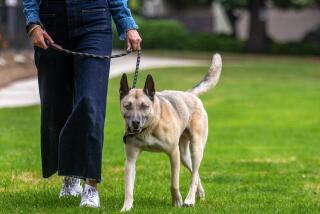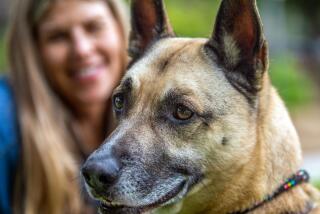Deliberate Quest for Ferocity Bred Dog That Killed Woman
Bane, the English mastiff crossbreed that fatally mauled a San Francisco woman, is part of a new generation of fighting dogs being bred for size and ferocity in a canine arms race that is yielding animals more than twice the size of the pit bull.
The 123-pound animal leapt at Diane Whipple last week and clamped its large jaws around her neck, killing her in an attack so vicious that police later needed counseling.
Authorities allege the animal--which even before the incident was nicknamed Killer Dog and Dog of Death by neighbors--was one of several connected with an enterprise to breed and sell aggressive dogs that was being run, illegally, by two white supremacists from Pelican Bay State Prison.
For more than two decades, the 50-pound pit bull has dominated fighting rings. But promoters have begun looking for a bigger dog, like the mastiff.
Mastiffs are strong, weigh as much as 200 pounds and have powerful jaws, but are not considered smart, said Howard White, a spokesman for the Humane Society of the U.S. As a result, dog fighting promoters started crossbreeding mastiffs with dogs more inclined to aggression, such as the pit bull, creating a crossbreed so vicious it is nicknamed the land shark.
For years, pit bulls--descendants of bulldogs and terriers--have been popular as guard dogs in blue-collar neighborhoods, protecting homes and small businesses, as well as crack houses and chop shops. Backyard breeding became so popular that Los Angeles County officials estimate half of the 44,000 dogs taken into shelters each year are some kind of pit bull or pit bull cross.
Experts say dog fighting is popular in Southern California, especially in Los Angeles and the Antelope Valley. It has grown from a secret activity, drawing a small number of breeders and spectators, into a moneymaking backyard enterprise. Today, amateurs and scores of breeders have joined the ranks of those hoping to make quick money off mean-tempered dogs. A top fighting dog can sell for as much as $30,000, according to experts.
The reason for the popularity of dog fighting is unclear.
“What makes people do what they do, like the shooting at Columbine?” asked Det. Bob Beals, a Los Angeles County Sheriff’s deputy, whose expertise is in illegal dog fighting. “Dogs can be molested as puppies or kicked around. If they are made to be malicious, they will be.”
Growing numbers of pit bull attacks, beginning in the 1980s, drew efforts to control the aggressive animals and prompted threats to ban the breed altogether. They mauled strangers and family members alike, with powerful jaws that are almost impossible to dislodge during an attack.
Today, it seems, pit bulls are not enough. “Now there’s the thought of trying to come up with a stronger, meaner dog,” said Teri Austin, president of the Amanda Foundation, which rescues dogs from Los Angeles animal shelters. “This is where mastiffs come in, a more efficient killing machine.”
She notes a recent upsurge of mastiffs among dogs being brought to Los Angeles County animal shelters.
“They’re more and more popular,” she said. The trouble she added, is “it’s like having a small horse in your house.”
In the San Francisco case, Whipple--who weighed 112 pounds--was overwhelmed by Bane, a cross between an English mastiff and a Canary Island--also known as Presa Canario. The Canary Island breed is known for its intelligence, speed and “trainability,” as well as its ability to be aggressive, White said. It is also considered a ferocious guard dog that will not hesitate to attack.
The 33-year-old lacrosse coach was among 15 to 20 people killed by dogs in the United States each year, experts said. Although most dog owners abhor aggression in their canine charges, such behavior is valued by those who run dog fights or sell guard dogs. Little is known about how the two animals were trained.
Hera, the other dog that joined Bane in Friday’s attack, was a purebred Canary Island, police said. Hera tore at Whipple’s clothing and is being held at a shelter.
Crossbreeding Creates Danger
Breeders say the problem is not any particular breed, but the effects of crossbreeding combined with training for aggression.
“You start mixing things and you lose stability,” said Angelika Morwald, owner of WereWolf Kennel in Ontario, Canada, which breeds Presa Canario dogs. Morwald said that Presa Canario dogs are extremely athletic. She has one that can jump an 8-foot fence.
“Purebred Canary Island dogs are very stable, but 75% of the dogs in the U.S. are not purebred,” she said. “The problem is that these guys are so powerful and when they’re crossed with something like a pit bull, you don’t know what you’re getting.”
Four components make up a dog’s personality: socialization, environment, breeding and dog-owner relationship, said Los Angeles dog trainer Matthew Margolis. Margolis does not believe Bane was a good dog gone bad.
“This dog obviously is genetic nightmare,” said Margolis, the author of “GRRR,” a book on canine aggression. “It’s not a stable animal; it’s like a wild beast.”
Dogs trained to fight are usually mistreated to elicit aggression. As puppies, these dogs are often kept isolated, staked to 2-foot-long chains. Sometimes they are denied food and then tied to a device similar to a miniature horse walker, where a cat or rabbit has been tied to a spoke just ahead of the dog. Periodically, the dog is allowed to devour the bait animal.
These dogs are praised when they snap or growl. Occasionally, an electric shock is applied to their genitals, said Austin.
To strengthen the puppies, some breeders tie 10-pound dumbbells to their necks. Often, tails and ears are clipped so opponents in the ring will have less to grab. These puppies are kept away from people to foster suspicion.
Creating a fighting dog “is a lengthy process that begins with breeding” and evolves with training, said Eric Sakach, an expert witness and regional director of the Humane Society, based in Sacramento.
Puppies begin fighting as soon as they show signs of aggression, from six to 18 months.
“Dogs are curious. They try to please their master, and they really do want to learn,” Sakach said. “If you reward them with praise or food, you encourage certain behavior.”
The puppies who survive their first 18 months become top prospects. They are pitted against other dogs in a series of fights--no longer than five minutes--designed to build their confidence and expose them to various styles of fighting.
Next, a trainer will ascertain his dog’s “gameness,” his endurance and ability to withstand injuries. Typically, a young dog will fight until it is exhausted. At that point, the opponent is replaced with a fresh dog. If the young dog continues to fight, it is considered to have potential.
California and 44 other states classify dog fighting as a felony. But experts say the operation, like drug dealing, is portable and can continue undetected in neighborhoods.
The fighting dog, said Sakach, is “essentially livestock to be used like a gladiator.”
*
Times staff writer Maria LaGanga contributed to this story.
(BEGIN TEXT OF INFOBOX / INFOGRAPHIC)
Profiles of the Breeds
The dog that killed Diane Whipple was a cross between an English mastiff and a Canary Island dog (also known as Presa Canario), which are both ancient breeds originally bred for fighting. Here’s a look at both:
*
English Mastiff
* Features: Color usually fawn, apricot or brindle, with black mask and ears and medium to short coat. Large head, broad chest and powerful hindquarters.
* Weight: 120-170 pounds.
* Life span: 6-10 years.
* Origin: Dates back to ancient Asia, but British created the breed as it exists today. First exported from Britain to Rome as military and fighting dog, mastiffs were also used to guard castles, carry heavy loads and turn wheels to draw water from wells.
*
Canary Island Dog
* Features: Color usually red or black brindle. Broad muzzle, thick neck skin covering powerful muscles; square head is nearly as wide as it is long.
* Weight: 84-106 pounds.
* Life span: 9-11 years.
* Origin: Canary Islands in 1800s. Ancestry possibly includes now-extinct Canary Islands breed Bardino Majero crossed with English mastiff. By 1960s, breed was nearly extinct but was revived by an American veterinarian. Developed specifically for use as a catttle dog and for fighting, especially in rings or pits in Canary Islands.
Sources: The Encyclopedia of the Dog; Mastiff Club of America
Researched by JULIE SHEER / Los Angeles Times
More to Read
Sign up for Essential California
The most important California stories and recommendations in your inbox every morning.
You may occasionally receive promotional content from the Los Angeles Times.










